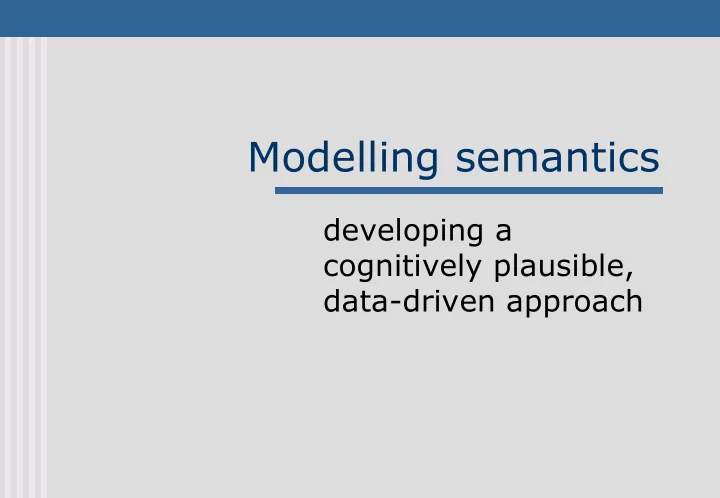

Modelling semantics developing a cognitively plausible, data-driven approach
Objective � Develop a model of semantics that is wide-coverage, cognitively plausible and computationally useful � Data-driven approach: � technically feasible, empirically grounded, scale, potential for practical utility � but linguistic and cognitive motivation?
Semantics in computational linguistics � Compositional semantics � `deep’ grammars � shallow/intermediate grammars � Lexical semantics � manually constructed ontologies: e.g., WordNet � data-driven: e.g., clustering � Combined, data-driven approaches � Lin et al, Curran, Lapata � but surprisingly little work
Integrated approaches � Compositional semantics the dog doesn’t like peppermint the’(x, dog’(x), h1), not’(like’(e,x,y)), bnpq(y, peppermint’(y), h2) � Open-class predicates correspond to region(s) in semantic `space’ � peppermint’ – unary predicate � like’ – three regions – event, experiencer, stimulus
Polysemy: bank
Polysemy: twist
Vector-space models from corpora � Hypothesis: semantic space can be derived from textual context in corpora � Relationship to classical lexical semantics? polysemy, synonymy, antonymy, metonymy etc � Relationship to psycholinguistic experiments? Quantifiable predictions? � Task-based evaluation: word/phrase prediction?
From distribution to semantics � Robust morphological, syntactic and compositional semantic processing � Iterated sense disambiguation with respect to derived soft clusters � Document structure, anaphora resolution etc
Some text corpora issues � Spoken language vs written language � speech transcription, quantity of data, disfluencies etc � Personal vs non-personal settings � shared context, background knowledge � Individual experience: compare balanced and longitudinal corpora
Summary � Develop a model of semantics that is cognitively and linguistically plausible while practically tractable and useful � Exploit text corpora to provide scale � Exploit and further develop tools for large- scale text processing � Investigate how balanced corpora relate to individual experience � Evaluate against human experiments
Potential participants include � Cambridge: Copestake, Briscoe, Marslen-Wilson � Sheffield: Lapata � Edinburgh: Keller, Pickering
Recommend
More recommend